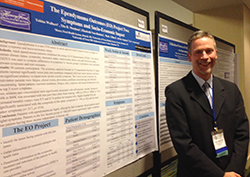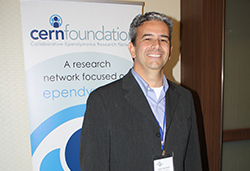CERN Foundation At The 2013 Annual Society For Neuro-Oncology Meeting
— Categories: Press Release Posted on December 16, 2013
The 4th Quadrennial Meeting of the World Federation of Neuro-Oncology was held in conjunction with the 18th Annual Scientific Meeting and Education Day of the Society for Neuro-Oncology on November 21-24, 2013 in San Francisco, CA.
The meeting enjoyed record attendance of close to 2100 registrants from 46 different countries, making it the largest neuro-oncology conference ever held. Researchers supported by the CERN Foundation were well represented at the meeting, and a brief synopsis of their key findings is provided below.
 Dr. Tobias Walbert
Dr. Tobias Walbert
The Ependymoma Outcomes (EO) Project Two: Symptoms and Socio-Economic Impact
At last year’s (2012) Society of Neuro-Oncology meeting, we presented data on the socio-economic impact of ependymoma. Based on that work, we extended our analysis and looked at the symptoms of patients with ependymoma and how these symptoms might affect their socio-economic status.
The Ependymoma Outcomes (EO) project is designed to collect patient reported data regarding the clinical presentation and course through an online survey. Adult ependymoma patients completed the EO Questionnaire (EOQ). The EOQ is a detailed questionnaire that captures disease status, symptoms, clinical insurance status, employment, direct costs, quality of life issues and functional status. ANOVA testing was used to compare differences in symptoms by income groups. We tested income groups to compare differences in symptoms. Correlations were calculated between symptoms and cost estimates.
A total of 86 patients participated. The economic analysis focused on 78 respondents from the U.S. Patients with spinal tumors reported significantly worse pain and numbness compared to brain tumor patients, and had a (non-significant) tendency to report more severe overall symptoms. The five most severe symptoms for brain tumor patients were fatigue, altered vision, drowsiness, problems remembering and difficulty concentrating. Spine patients reported numbness, fatigue, pain, weakness and sexual dysfunction to be the top five worst symptoms. Pain, seizures and concentration were significantly associated with self-reported income. Estimated monthly co-pays were between $75 and $176 dollars for hospital bills. Higher hospital bills are significantly associated with the composite of the spine symptoms and the brain tumor symptoms.
We concluded that patients with ependymoma are highly affected by their symptoms. Patients with spinal tumors report more symptoms. Patients in the low-income group of <$40,000 report significantly greater symptoms than patients having more income independent of disease site.
 Elizabeth Vera-Bolaños
Elizabeth Vera-Bolaños
Structure and Reliability of the Dexamethasone Symptom Questionnaire: Chronic (DSQ-C) in Primary Brain and Metastatic Brain Tumor Patients
Corticosteroids, often given as initial treatment to alleviate symptoms of peritumoral edema (swelling) in patients with brain tumors, can have numerous side effects that affect the patient’s quality of life and treatment tolerance. The Dexamethasone Symptom Questionnaire-Chronic (DSQ-Chronic) was initially developed to report the incidence and severity of symptoms associated with corticosteroid use. This study’s objective was to evaluate select measures of reliability and validity of the DSQ-Chronic in brain tumor patients using corticosteroids.
Our 96 participants were primarily white men with primary or metastatic brain tumors aged 20-75 years (mean 52). 74% were treated with corticosteroids with a median dose of 4 mg/day for a median duration of 1 month (range 0-26 months). Over 35% of those on corticosteroids experienced “quite a bit” to “very much” increased appetite and trouble sleeping. Factor analysis revealed an underlying construct being measured by the 17-item DSQ-Chronic and explaining 22% of variance. The internal consistency (reliability) of the DSQ-Chronic was very good at 0.77. The DSQ-Chronic discriminated (distinguished) between patients who were on steroids and those not. The cumulative steroid dose was the product of the daily dose (mg/day) and total days of use. The cumulative steroid dose predicted DSQ-Chronic scores and increased the odds of experiencing increased appetite, hiccups, roundness of face, depression and difficulty standing.
This pilot study demonstrates the potential of the DSQ-Chronic to be used as a screening tool for symptoms that are associated with corticosteroid use in brain tumor patients. Future analyses include modifying the instrument and identifying underlying constructs that better describe the symptoms effects specific to brain tumor patients.
 Lin Lin
Lin Lin
The Change of Uncertainty Over Time in Patients With Primary Brain Tumors (PBTs)
The illness trajectory of patients with PBTs is associated with high incidence of uncertainty. Overall, uncertainty remained constant when patients were followed longitudinally. Uncertainty related to the unpredictability of the disease and symptoms lessened after completion of treatment, whereas unpredictability related to the prognosis appeared to increase over time, even in the setting of stable disease. Evaluating patients with different levels of uncertainty longitudinally offers better understanding of the patterns of change over time. The findings may help healthcare providers to develop a more individualized symptom management paradigm to lessen uncertainty and improve quality of life.
 Alvina Acquaye
Alvina Acquaye
Hope in Glioma Patients
We studied the relationship of hope to disease status and symptom burden in patients with primary brain tumors (PBT). Patients diagnosed with a life threatening illness generally feel they have limited options in improving quality of life during this unexpected period in their lives. Learning to cope with such a debilitating disease can be difficult. Being hopeful is often considered an important factor in personal adjustments but is plagued by illness-related uncertainty. A cross-sectional sample of adult PBT patients completed the Hearth Hope Index (HHI). The HHI is a 12-item assessment of hopefulness with three subscales (temporality and future, positive readiness/expectancy and interconnectedness). Data was collected on two patient groups (follow-up and on active treatment). The sample included 71 patients and as expected, patients not on active treatment and without tumor recurrence reported higher levels of hope than their counterparts. Furthermore, the results indicate high symptom burden and interference is associated with lower hope scores. Future studies are needed to focus on this relationship to implement ways to improve one’s coping skills in dealing with diagnoses and treatment changes.
 Saba Abutaseh
Saba Abutaseh
CERN Foundation Exhibit: To create more awareness for the CERN Foundation.
Saba Abutaseh displayed CERN information at the exhibit area where other doctors could ask questions about the Foundation.
